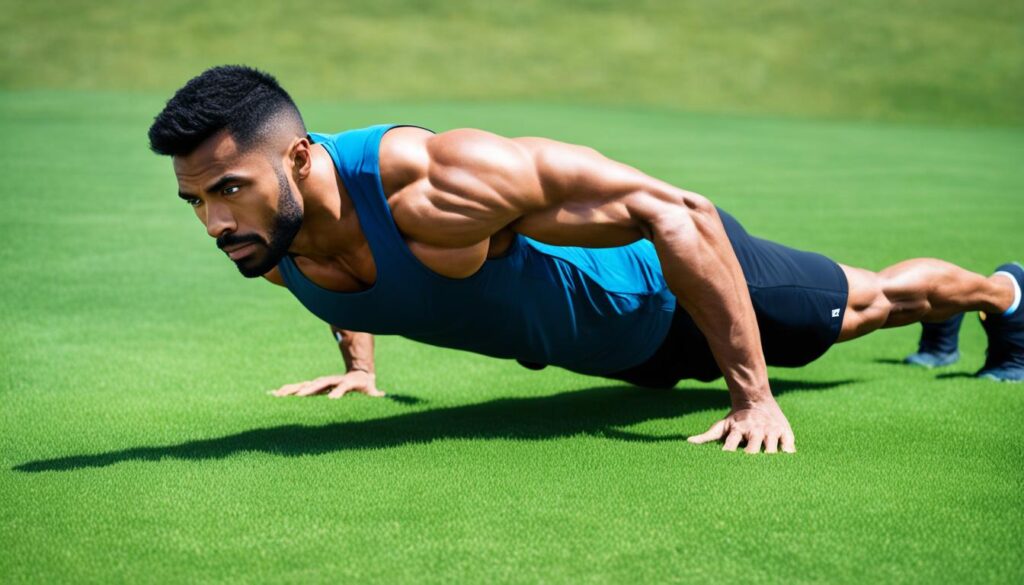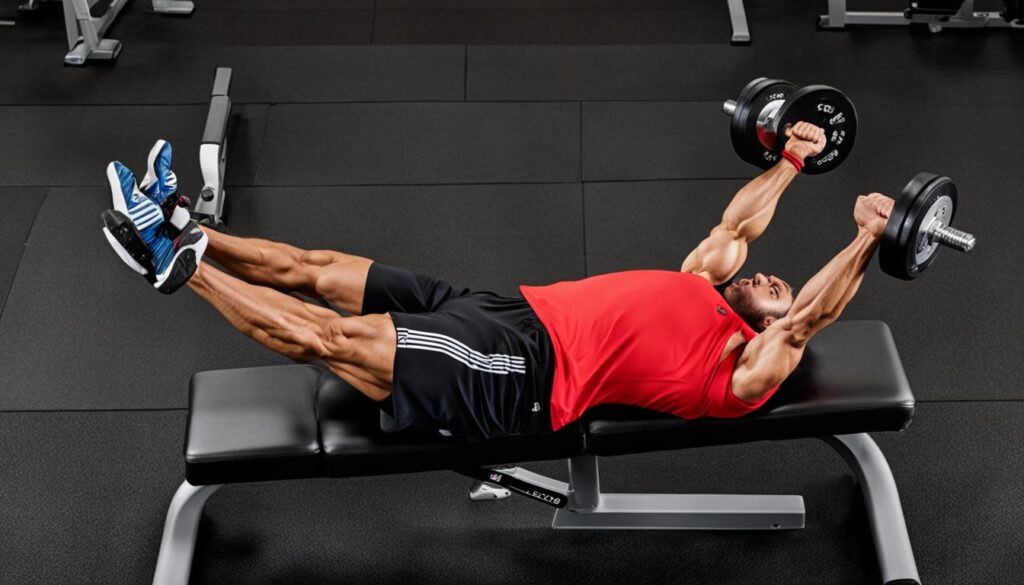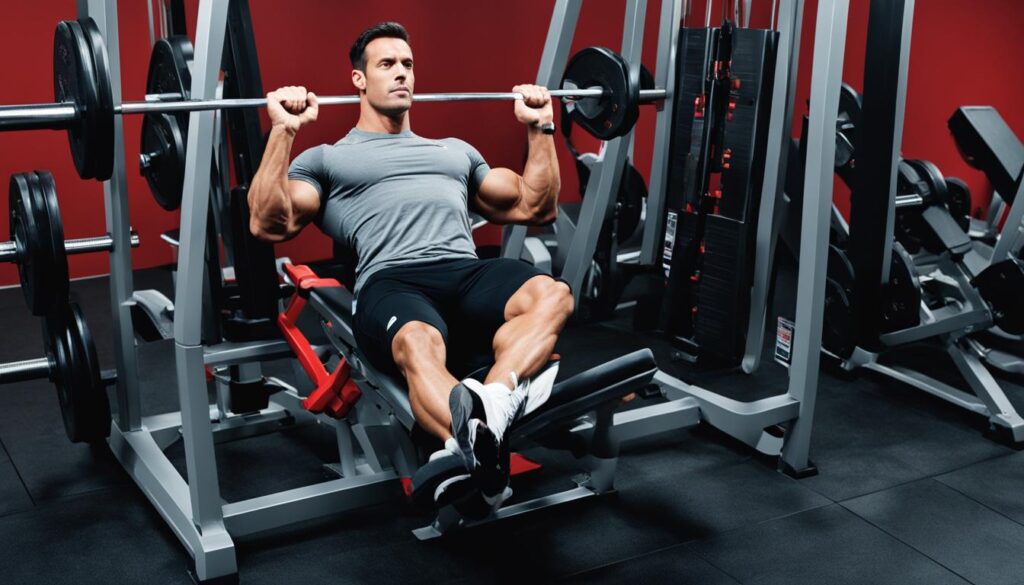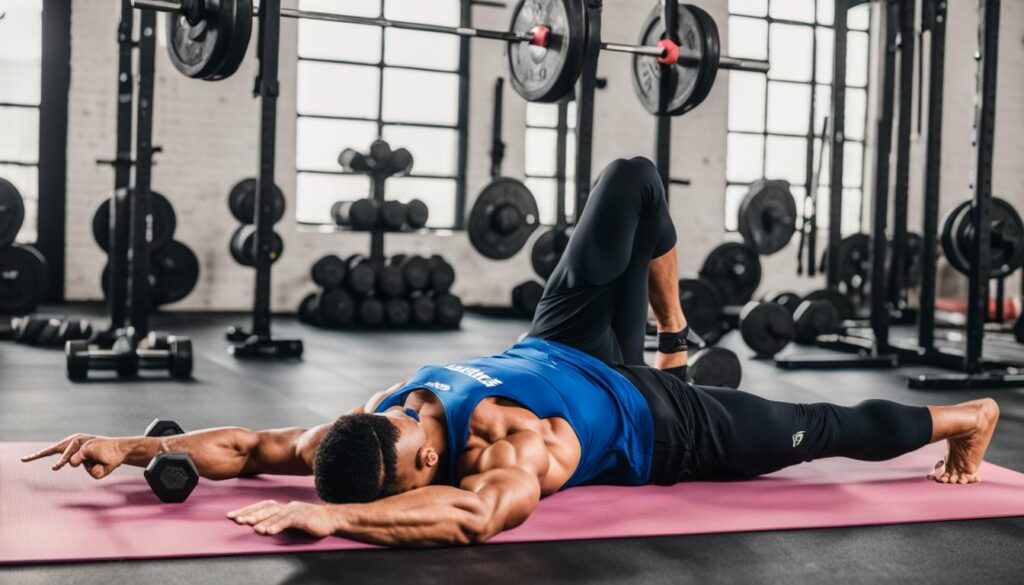Fitness >Running
7 Weightlifting Exercises for Beginners to Ease into a New Routine
Welcome to the world of weightlifting! If you’re new to this form of exercise and looking to establish a solid routine, you’re in the right place. Weightlifting is a fantastic way to build strength, increase muscle mass, and improve overall fitness. However, it’s essential to start slowly and focus on exercises that are suitable for beginners. In this article, we’ll explore seven weightlifting exercises specifically designed to help you ease into a new routine.
Before we dive into the exercises, let’s take a moment to discuss some important tips for starting your weightlifting journey:
 Next, let’s discuss another essential weightlifting exercise for strengthening the back and biceps: rows.
Next, let’s discuss another essential weightlifting exercise for strengthening the back and biceps: rows.
Remember to choose a row variation that matches your fitness level and gradually increase the intensity as you become stronger. Always prioritize proper form and technique to avoid injury and maximize the effectiveness of the exercise.
Next, we’ll explore another fundamental weightlifting exercise: chest presses. Keep reading to discover the benefits of chest presses and different variations you can incorporate into your routine.
 There are several variations of chest presses that you can choose from, depending on your fitness level and equipment availability. Some popular variations include:
There are several variations of chest presses that you can choose from, depending on your fitness level and equipment availability. Some popular variations include:

 Remember, consistency is key when it comes to developing core strength. Aim to incorporate abdominal exercises into your routine at least 2-3 times a week. As your core becomes stronger, you can gradually increase the intensity, duration, or difficulty of the exercises to continue challenging your muscles.
Remember, consistency is key when it comes to developing core strength. Aim to incorporate abdominal exercises into your routine at least 2-3 times a week. As your core becomes stronger, you can gradually increase the intensity, duration, or difficulty of the exercises to continue challenging your muscles.
- Focus on compound movements that engage multiple joints and muscles.
- Include both pushing and pulling exercises to maintain muscular balance.
- Begin with a weight that allows you to perform 6 to 12 repetitions with proper form.
- Rest for 2 to 5 minutes between sets to allow for recovery.
Key Takeaways:
- Weightlifting is a great way for beginners to build strength and increase muscle mass.
- Start with compound exercises that work multiple muscle groups.
- Include both pushing and pulling exercises for balanced muscle development.
- Choose weights that allow for 6 to 12 reps with proper form.
- Rest for 2 to 5 minutes between sets to allow for recovery.
The Benefits of Weightlifting for Beginners
Weightlifting offers numerous benefits for beginners. It helps build muscle mass, increase strength, improve bone density, boost metabolism, and enhance overall fitness. Regular weightlifting can also reduce the risk of injury, improve posture, and enhance athletic performance. Starting a weightlifting routine can be a great way to kickstart your fitness journey and achieve your goals. When you engage in weightlifting for beginners, you’ll notice significant changes in your body composition. As you build muscle mass, your body will become more toned and defined. This can lead to a more sculpted physique and improved self-confidence. Another benefit of weightlifting is increased strength. As you lift weights and challenge your muscles, they adapt and become stronger over time. This can improve your ability to perform everyday tasks, such as lifting heavy objects or carrying groceries. Weightlifting also has a positive impact on bone density. By placing stress on your bones, weightlifting stimulates bone growth, making them stronger and less prone to fractures and osteoporosis. In addition, weightlifting boosts metabolism. As you build lean muscle mass, your body requires more energy to maintain and repair the muscles. This increases your basal metabolic rate (BMR), leading to more calories burned even at rest. This can be beneficial for weight management and achieving a leaner body composition. One of the often overlooked benefits of weightlifting is its effect on posture. By strengthening the muscles in your back, shoulders, and core, weightlifting improves postural alignment and reduces the risk of developing hunched shoulders or a rounded back. Furthermore, weightlifting can enhance athletic performance in other physical activities. Stronger muscles provide a solid foundation for improved performance in sports, running, or any other physical activity. Starting a weightlifting routine doesn’t require expensive equipment or a gym membership. You can begin with simple exercises using just your body weight or easily accessible dumbbells. As you progress, you can gradually increase the weights and challenge yourself. To get started with weightlifting for beginners, consider consulting a personal trainer or fitness professional. They can guide you on proper form, exercise selection, and gradually progressing your routine. Remember to start with lighter weights and focus on mastering the correct technique before increasing the load. With consistent effort and a well-designed weightlifting routine, you can experience all the benefits that weightlifting has to offer. So why wait? Start your weightlifting journey today and unlock a stronger, healthier version of yourself.Squats: The King of Weightlifting Exercises
Squats are considered the king of weightlifting exercises due to their ability to engage multiple muscles, including the glutes, quadriceps, hamstrings, and core. They are a fundamental compound movement that should be a staple in any leg strength training routine. There are several variations of squats that you can incorporate into your workouts to challenge your muscles in different ways and prevent boredom. Some popular squat variations include: Each variation targets slightly different muscle groups and may require different levels of balance and stability. Feel free to experiment and find the variations that work best for you.The Mechanics of a Proper Squat
To perform a squat correctly, follow these steps:- Stand with your feet shoulder-width apart, toes slightly turned out.
- Engage your core and maintain a straight back throughout the movement. Keep your chest up and your gaze forward.
- Initiate the squat by bending at your hips and knees, pushing your hips back as if you’re sitting into a chair.
- Lower yourself until your thighs are parallel to the ground or slightly below, making sure your knees stay aligned with your toes.
- Push through your heels and extend your hips and knees to return to the starting position.
Push-Ups: A Full-Body Strength Exercise
Push-ups are a classic exercise that targets the chest, shoulders, triceps, and core muscles. They are a great full-body strength exercise that can be modified to suit different fitness levels. Variations of push-ups:- Incline push-ups: Place your hands on an elevated surface, such as a bench or step, to decrease the amount of body weight you’re pushing.
- Decline push-ups: Elevate your feet by placing them on a bench or step, increasing the intensity and emphasizing the upper chest muscles.
- Diamond push-ups: Form a diamond with your hands, touching your thumbs and index fingers. This variation targets the triceps and inner chest muscles.
- Building upper body strength
- Toning the chest, shoulders, and triceps
- Engaging the core muscles for stability
“Push-ups are a versatile exercise that can be done anywhere, without any equipment. They are an effective way to build upper body strength and can be modified to meet your fitness level.”Whether you’re a beginner or an advanced lifter, push-ups are a valuable addition to your workout routine. Start with the basic push-up and gradually progress to more challenging variations to continuously challenge your upper body strength.
 Next, let’s discuss another essential weightlifting exercise for strengthening the back and biceps: rows.
Next, let’s discuss another essential weightlifting exercise for strengthening the back and biceps: rows.
Rows: Strengthening the Back and Biceps
Rows are an essential component of any well-rounded weightlifting routine, as they effectively target the back and biceps muscles. Incorporating row exercises into your workout regimen can help improve posture, strengthen the upper back, and develop a strong grip. There are several variations of rows that you can incorporate into your routine, including:- Bent-Over Rows: This exercise involves bending at the hips, maintaining a flat back, and pulling the weight towards your chest.
- Seated Rows: Seated rows are typically performed using a cable machine or resistance bands while sitting upright. This variation allows for focused activation of the back muscles.
- Inverted Rows: Also known as bodyweight rows, inverted rows are performed by lying under a bar or using suspension straps and pulling your chest towards the bar.
The Importance of Rows in a Balanced Weightlifting Routine
Rows play a crucial role in maintaining muscular balance and preventing muscle imbalances that can lead to injury. They complement pushing exercises, such as chest presses and push-ups, by targeting the opposing muscles in the back and biceps. This balance is important for overall posture and stability.“Rows are a great exercise for targeting the back and biceps. They help build a strong upper body and improve functional strength for everyday activities.” – Fitness Trainer, Jane SmithAdditionally, rows engage the muscles of the upper back, including the rhomboids, traps, and rear deltoids, contributing to a well-developed and defined back. Strong back muscles not only enhance your overall physique but also improve posture and spinal alignment. Take a look at the table below for a comparison of the different row variations:
| Row Variation | Muscles Targeted | Difficulty Level |
|---|---|---|
| Bent-Over Rows | Upper back, biceps | Intermediate |
| Seated Rows | Upper back, biceps | Beginner |
| Inverted Rows | Upper back, biceps | Advanced |
Chest Presses: Building Pectoral Muscles and Triceps
When it comes to building upper body strength and developing well-defined chest and arm muscles, chest presses are essential. Chest presses are pushing exercises that primarily target the pectoral muscles (chest muscles) and triceps. By incorporating different variations of chest presses into your workout routine, you can effectively build muscle mass and improve overall upper body strength. There are several variations of chest presses that you can choose from, depending on your fitness level and equipment availability. Some popular variations include:
There are several variations of chest presses that you can choose from, depending on your fitness level and equipment availability. Some popular variations include:
- Bench presses: Done with a barbell or dumbbells on a flat bench, this exercise engages the pectoral muscles, triceps, and shoulders.
- Dumbbell presses: Similar to bench presses, but performed with dumbbells, allowing for a greater range of motion and more individualized control.
- Cable chest presses: Utilizing a cable machine, this exercise provides constant resistance throughout the entire movement, targeting the chest and triceps.
The Benefits of Chest Presses
Chest presses offer a variety of benefits beyond building muscle mass in the chest and arms. By regularly incorporating chest presses into your workout routine, you can:- Strengthen the pectoral muscles and triceps for improved upper body strength and power.
- Enhance overall muscle definition and create a more aesthetic physique.
- Improve pushing movements in daily activities and sports.
- Increase bone density and support joint stability.
Chest presses are an effective way to target and strengthen the chest and tricep muscles. By incorporating different variations of chest presses into your workout routine, you can develop a well-defined chest and build upper body strength.
Pulldowns and Pull-Ups: Strengthening the Back and Arms
If you’re looking to strengthen your back and arms, pulldowns and pull-ups are two excellent exercises to incorporate into your routine. These pulling exercises target the muscles of the upper body, helping to build strength and improve posture. Pulldowns are typically performed using a cable machine. They involve pulling a bar or handle down towards your chest while sitting on a bench or in an upright position. This exercise primarily targets the back muscles, including the latissimus dorsi (lats) and the rhomboids. By doing pulldowns, you can effectively strengthen your back and enhance your overall upper body strength. Pull-ups, on the other hand, are performed using a bar that is suspended overhead. This exercise requires you to hang from the bar and pull your body up until your chin reaches or surpasses the bar. Pull-ups primarily target the back muscles, including the lats and the muscles of the arms, such as the biceps and forearms. They are a challenging exercise that can help you develop upper body strength and improve your grip. When performing pull-ups, you can modify the exercise to suit your fitness level. Assisted pull-ups, for example, use a resistance band or a machine to reduce your body weight and make the exercise more manageable. Chin-ups, on the other hand, involve a supine grip with your palms facing you, targeting slightly different muscles compared to traditional pull-ups.Pulldowns and Pull-Ups: Benefits and Recommendations
By incorporating pulldowns and pull-ups into your workout routine, you can experience several benefits:- Strengthening the back muscles, including the lats, rhomboids, and other muscles in the upper back
- Improving posture by developing the muscles responsible for maintaining an upright position
- Enhancing overall upper body strength and muscle definition
- Engaging the muscles of the arms, including the biceps and forearms
- Start with proper form: Ensure that you have the correct technique and body positioning to effectively engage the target muscles.
- Begin with a suitable resistance: Choose a weight or assistance level that allows you to complete the desired number of repetitions with proper form and without straining excessively.
- Progress gradually: As you get stronger, challenge yourself by gradually increasing the weight, decreasing assistance, or increasing the difficulty of the exercise.
- Include variety: Try different grip widths and variations to target different muscles and add variety to your routine.
Leg Press: Building Lower Body Strength
When it comes to lower body strength exercises, the leg press is a standout performer. This compound exercise targets key muscles in your lower body, such as the quadriceps, hamstrings, and glutes. Whether you’re a beginner or someone with knee issues, the leg press offers a great alternative to squats. The leg press can be performed using a leg press machine at the gym or even at home with the help of resistance bands. This versatility allows you to engage in leg strength exercises regardless of your surroundings or equipment availability. Not only does the leg press help build lower body strength, but it also offers multiple benefits for your lower body muscles. By engaging the quadriceps, hamstrings, and glutes, the leg press helps improve muscle definition, power, and overall stability. If you’re looking for an exercise that specifically targets your legs and helps you build strength in that area, the leg press is an excellent choice. Unlike squats, which engage multiple muscle groups, the leg press allows you to isolate your leg muscles, making it an effective tool for targeted leg workouts.
“The leg press is a fantastic exercise for building lower body strength. It targets the quad muscles, hamstrings, and glutes, helping you achieve a well-rounded lower body workout.”Whether you’re a fitness enthusiast or new to weightlifting, incorporating the leg press into your lower body exercises can yield impressive results. Keep in mind that proper form and technique are crucial to maximize the benefits and prevent injury. Remember, each individual has different fitness levels and goals. It’s important to adjust the leg press exercise to suit your specific needs. Consult a fitness professional or trainer for guidance and personalized recommendations that align with your capabilities.
Leg Press Exercise Tips:
- Start with a weight that challenges you, but allows you to complete the movement with proper form.
- Avoid locking your knees at the top of the movement to maintain tension and reduce stress on the joints.
- Keep your back flat against the pad and ensure your feet are positioned shoulder-width apart for stability.
- Push through your heels as you extend your legs, focusing on engaging the quadriceps, hamstrings, and glutes.
- Control the weight as you lower it back down, feeling the tension in your leg muscles throughout the entire range of motion.
Abdominal Exercises for Core Strength
Building a strong core is essential for overall strength and stability. Having a strong core not only improves your performance in other exercises but also helps prevent injuries and supports proper posture. Including abdominal exercises in your fitness routine is key to developing core strength. Abdominal exercises specifically target the muscles in your core, which include the rectus abdominis (six-pack muscles), transverse abdominis (deep muscles), obliques (sides of the waist), and lower back. These exercises not only help you achieve a toned and defined midsection but also contribute to improved spinal alignment and posture. There are various types of abdominal exercises that cater to different fitness levels and goals. Two effective exercises to incorporate into your routine are abdominal flexion and planks.Abdominal Flexion
Abdominal flexion exercises, also known as crunches or sit-ups, are a classic way to target the rectus abdominis muscles and develop a strong core. To perform an abdominal flexion exercise:- Lie on your back with your knees bent and feet flat on the floor.
- Place your hands behind your head or across your chest.
- Tighten your core muscles and lift your upper body, curling your shoulders off the ground.
- Lower yourself back down with control, maintaining tension in your core.
- Repeat for the desired number of repetitions.
Planks
Planks are a highly effective exercise for strengthening the entire core, including the rectus abdominis, obliques, transverse abdominis, and lower back muscles. Planks also engage the muscles of the shoulders, arms, and legs, making it a full-body exercise. To perform a plank:- Start in a push-up position with your hands directly under your shoulders and feet hip-width apart.
- Engage your core muscles and maintain a straight line from your head to your heels.
- Hold this position for as long as you can while maintaining proper form and breathing normally.
- Release and rest briefly before repeating for multiple sets.
 Remember, consistency is key when it comes to developing core strength. Aim to incorporate abdominal exercises into your routine at least 2-3 times a week. As your core becomes stronger, you can gradually increase the intensity, duration, or difficulty of the exercises to continue challenging your muscles.
Remember, consistency is key when it comes to developing core strength. Aim to incorporate abdominal exercises into your routine at least 2-3 times a week. As your core becomes stronger, you can gradually increase the intensity, duration, or difficulty of the exercises to continue challenging your muscles.
Conclusion
Weightlifting is an essential component of a well-rounded fitness routine, particularly for beginners. By incorporating the seven mentioned weightlifting exercises into your workout regimen, you can achieve a comprehensive full-body workout that targets all major muscle groups. The benefits of weightlifting are numerous, including increased strength, enhanced muscle mass, improved posture, and overall fitness improvement. When starting a weightlifting routine, it’s important to prioritize proper form and technique. Begin with weights that challenge you but still allow you to maintain good form. Gradually increase the intensity and weight as you progress on your fitness journey. Prioritizing safety and gradual progress will help prevent injuries and ensure steady improvement. Before embarking on any new exercise routine, it’s always advisable to consult with a fitness professional or trainer. They can provide personalized guidance based on your individual fitness level, goals, and any specific concerns or limitations you may have. With their expertise, you can start your weightlifting journey confidently and effectively.FAQ
How often should I do strength training exercises?
It is recommended to strength train twice per week to significantly increase muscle mass.
What type of exercises should I focus on to get stronger?
Focus on compound movements that engage multiple joints and muscles.
Why is it important to include both pushing and pulling exercises in my routine?
Including both pushing and pulling exercises helps maintain muscular balance and works all major muscle groups.
What are some examples of compound exercises?
Examples of compound exercises include squats, push-ups, rows, and chest presses.
How many reps should I do as a beginner?
It is recommended to start with a weight you can lift for 6 to 12 reps per set with proper form.
How long should I rest between sets?
Rest for 2 to 5 minutes between sets to allow for recovery.
What are the benefits of weightlifting for beginners?
Weightlifting helps build muscle mass, increase strength, improve bone density, boost metabolism, and enhance overall fitness.
Can weightlifting reduce the risk of injury?
Yes, regular weightlifting can reduce the risk of injury, improve posture, and enhance athletic performance.
What is the king of weightlifting exercises?
Squats are considered the king of weightlifting exercises due to their ability to engage multiple muscles in the lower body.
How can I modify squats to accommodate different fitness levels?
Squats can be modified using variations such as goblet squats, sumo squats, and Bulgarian split squats.
Which muscles do push-ups target?
Push-ups target the chest, shoulders, triceps, and core muscles.
Can push-ups be modified for different fitness levels?
Yes, push-ups can be modified using variations such as incline push-ups, decline push-ups, and diamond push-ups.
What muscles do rows target?
Rows target the back and biceps muscles.
How can I modify rows to suit my fitness level?
Rows can be modified using variations such as bent-over rows, seated rows, and inverted rows.
What muscles do chest presses target?
Chest presses primarily target the pectoral muscles (chest muscles) and triceps.
Can I do chest presses with different equipment?
Yes, chest presses can be done with dumbbells, barbells, or machines.
Which muscles do pulldowns and pull-ups work?
Pulldowns and pull-ups work the back and arm muscles.
How can I modify pull-ups to make them easier?
Pull-up variations include assisted pull-ups and chin-ups.
What muscles does the leg press target?
The leg press focuses on the quadriceps, hamstrings, and glutes.
Can I do the leg press without a machine?
Yes, the leg press can also be done with resistance bands.
Why are abdominal exercises important for core strength?
Abdominal exercises target the core muscles and help improve posture and spinal alignment.
How can I modify abdominal exercises to suit my fitness level?
Abdominal exercises can be modified to suit different fitness levels and abilities.
Is it important to consult with a fitness professional before starting a weightlifting routine?
Yes, it is always important to consult with a fitness professional or trainer before starting any new exercise routine.
